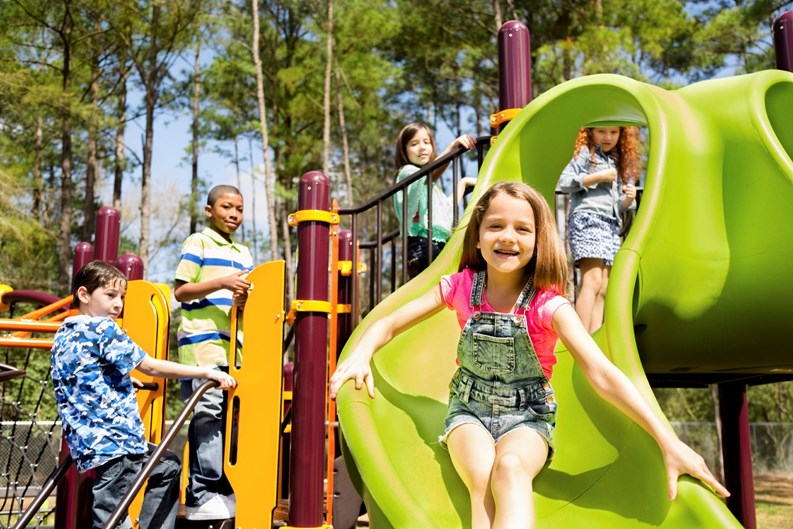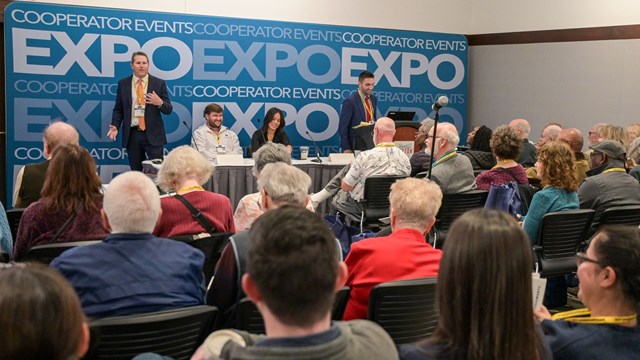One universal truth on which we all can agree is that kids like to play. They love little more than getting together and having a bang-up good time. And in almost any cooperative, condominium or homeowners’ association, there is likely to be a gaggle of youths who need to burn off some energy. A board is left with the choice between letting this roving band of rapscallions traverse the property unchecked, wreaking havoc on carefully-manicured lawns, or providing a designated place for kids to gather and enjoy some fresh air. Should said board wisely adopt the latter strategy, there’s a name for this type of consolidated entertainment structure, what we call: a playground.
Clearly, the imperative when housing a playground on a condo or co-op premises is safety. There may also ensue shifting community dynamics or potential lawsuits should a child get hurt. Thus every precaution must be taken to prevent that from happening. So what’s new in playground safety? What materials are being adapted into the works? Are kids playing differently than they were, say, a decade ago?
The Local Report
Rules and regulations regarding playground safety—while a priority everywhere, obviously — can vary from state to state. In Massachusetts, there’s a Code of Mass. Regulations, or CMR, an umbrella under which playground regulations fall. “CMR spells out that there are numerous playground-related injuries annually, with children needing emergency room treatment,” says Frank Flynn, managing partner of Flynn Law Group in Boston. “Thus, playgrounds are highly regulated. Outdoor spaces must offer at least 75 square feet per child, they have to be accessible to children with disabilities, and they have to be appropriate for the specific age groups which they’re meant to serve.”
Meghan O’Brien, president of O’Brien & Sons, Incorporated, the largest supplier of outdoor recreation equipment in New England (and a certified playground safety inspector), urges boards to implement regular documented maintenance of their playground equipment. “Whether it’s daily, weekly or monthly, a board needs to set up a schedule and make [playground maintenance] someone’s responsibility, so that it’s covered in terms of liability,” she says. After the snow and ice has melted and the weather grows increasingly nicer, “you'll want to look for anything that has been vandalized, or is just broken. You’ll want to give the whole playground a once-over to make sure that it’s in sound condition, in regard to missing parts. You’ll want to make sure that the surfacing is adequate, as you typically need a ‘loose-fill’ surfacing with at least a 12-inch depth. Also, look for broken bottles or other objects in the area, and sticks that may have fallen.”
And should no one on hand have the time or the desire to scour the playground for hazards, O’Brien notes that a board can hire a playground inspector, whom it would pay to audit the space. “Everything stems from a risk management viewpoint,” she says. “If you set up an inspector to look at your playground or designate a board member to become certified themselves, and you’ve built yourself a maintenance plan according to regulation, then you’ve increased your risk management and reduced your liability.”
If a child were to get hurt on a condominium playground, there are certain variables that can affect liability. “If a condo allows a structure to fall into disrepair, and a child cuts him- or herself on a jagged edge, then that could be negligence, in which case the condo—since we’re dealing with a common area —would be responsible, as it failed to maintain something over which it had agency,” explains Flynn. “But if the structure is perfectly fine and meets all of the current standards, then the condo shouldn’t be considered at fault. There is no such thing as strict liability, which means that the condo isn’t the guarantor of all safety; you’d have to show that the condo acted negligently in some way. For example, were the condo to be in the midst of building a playground and had a giant pile of dirt on its grounds, and a child climbed on it, suffocated and died, that is clearly negligence, as the condo had a dangerous condition on its property and didn’t engage in due care.”
The Broadsheet
While each state, municipality, city or town may have its own minor variances regarding playgrounds and related issues, much of what governs the equipment on which children play around is regulated on the federal level.
“The Consumer Product Safety Commission has set standards for many years—since 1981,” explains Brandy Smith, project coordinator with the National Program for Playground Safety. “The CPSC produces the Handbook for Public Playground Safety, which was last re-evaluated in 2010. The information in this handbook is compiled by the American Society for Testing & Materials (ASTM), an international group that includes playground manufacturers, among many varied organizations, which meets twice per year, and from that stems the requisite evaluations.”
One of the major recent changes in playground regulation came from the Americans with Disabilities Act in 2012, at which point playgrounds were federally mandated to meet ADA requirements, according to Paul Edwardson, Certified Playground Safety Inspector Instructor for the National Recreation and Park Association.
“Many playground manufacturers have been achieving or exceeding ADA requirements for a while,” notes Karen Snyder, playground safety manager with the NRPA. “There is more recognition now for playgrounds to serve people of all abilities, so you’ll see inclusive equipment that allows able-bodied children to play directly alongside children with disabilities. There are also sensory playgrounds for people who deal with issues like autism. In 2014, Galveston County Parks and Senior Services in Texas put in the country’s first playground for seniors. So playgrounds continue to evolve to meet the needs of diverse audiences, and can be a great way for a community to express itself through play and play structures.”
In recent years, change in playground safety standards has been minimal. “Over the past few years, changes have been data driven, based on injury data or lack thereof,” says Edwardson. “For example, it used to be that, based on the height of a slide, it could be required to have up to 14 feet of clear distance at the end of a slide. Lack of injury data, however, showed that it could be relaxed, and now the minimum clear distance at the end of a slide is six feet, while the maximum requirement is eight feet.”
And Smith notes that one of the biggest changes in playground aesthetics of late is the incorporation of more natural elements. “It’s probably one of the hardest things to work with as far as standards, because a lot of the natural playgrounds contain organic elements. And you can’t put a standard on a rock. There’s a grey area when you’re not dealing specifically with manufactured playground equipment, and that’s one of the bigger challenges about which we get many phone calls right now, as programs move to the more natural motifs.”
The Front Lines
Nobody knows more about what’s hot and hip in the world of condo playground equipment than someone who makes playground equipment for the world of condos. Richard Hagelberg, an early childhood educator and the CEO of Kidstuff Playsystems in Gary, Indiana, has been in the recreational playground game for decades, and has the skinny on what’s new.
“Condos and HOAs are looking to maximize the amount of play value they can get for their money, which is why they’re a good niche market for us, a smaller playground manufacturer, to specialize,” he notes. “There are certain extremely fancy and expensive designs that appeal to the parks and rec market but those are usually outside the price range of the condo/co-op/HOA demographic.”
As far as what’s the rage these days, Hagelberg hasn’t seen the natural trend mentioned by Smith above permeating the condo market just yet. “There’s a company that makes something that looks like a giant tree, so if you have $50,000 to spend on such things, that will appeal to you. We re-sell play rocks that are 7-8 ft. high, 10-15 ft. long. But we don’t see much demand for them. We build a lot of climbing elements into our systems: climbing and sliding, overhead ladder-type elements are all still very popular. We have a big slide with three chutes that kids love. Spiral slides. One of the newer things is net climbers, but they can cost $15,000 plus installation. They’re more popular with parks and schools,” he says.
In regard to safety, Hagelberg strongly urges boards to maintain their surfaces. “A condo environment usually doesn’t want to spend money for a rubber tile surface; it’s more likely to opt for wood chips or loose rubber, both of which are softer than poured-in-place rubber or rubber tiles in terms of preventing broken arms and ankles. There’s nothing wrong with wood chips or loose rubber, it’s just that they’re maintenance-intensive, and the wood chips have to be maintained at a depth of 10-12 inches, and loose rubber needs to be maintained at a depth of six inches. Loose rubber is incredibly soft and nice to land on, but it gets displaced very easily.”
A newer, more modern concern that has emerged of late is simply getting the kids excited to go outside and play in the first place—what with touchscreens and apps running amok and capturing everyone’s time. “There’s been a shift in public attitude,” laments Hagelberg. “Kids are not getting exercise like they used to, with the predominance of computers and iPhones. While we haven’t noticed any hit in sales, I honestly don’t know how many people consider it vital in their environments to have a playground for kids.”
“We have this belief that we have to have some designated place for kids to play, but if you watch how they act naturally, they like to run,” adds Smith. “They like to jump. Sometimes it seems as if adults are pushing upon them this belief that they have to have something flashy. And granted, that flashy thing can help as a selling point for a condo. But a more optimistic mindset for a board would be ‘let’s have a green space that’s fenced in and is safe, in which kids can bring a ball and just play.’ That’s what’s behind the push for natural playgrounds. It’s not that you’re just leaving kids alone to destroy your grass; it’s a thoughtfully-planned approach to adhere to how kids naturally play. Watch your kids and see what they do, and then cater to that. It’s not rocket science. It’s how kids have always played. There’s just a different belief now as to what they actually need.”
Michael Odenthal is a staff writer for New England Condominium and other publications.







Leave a Comment